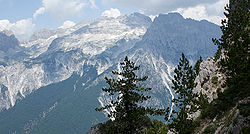Top 20 highest ultra prominent mountains in mainland Balkans
This is a list of the top 20 highest ultra prominent mountains in mainland Balkan Peninsula.
Contents
- Top 20 highest ultra prominent mountains in mainland Balkans
- List of peaks and sub-peaks of the Balkans above 2800 m
- More extensive list of the highest mountains, in broader sense, in mainland Balkan Peninsula, corresponding highest peaks, and locations
- See also
- References






| No | Mountain/Peak | Country | Elevation (m) | Prominence (m) | Col (m) |
|---|---|---|---|---|---|
| 1 | Rila/Musala | 2,925 | 2,473 | 432 | |
| 2 | Olympus/Mytikas | 2,917 [1] [2] | 2,353 [3] | 564 | |
| 3 | Pirin/Vihren | 2,915 [4] | 1,784 | 1131 | |
| 4 | Korab Mountain/Mount Korab | 2,764 | 2,169 | 595 | |
| 5 | Šar Mountain/Titov Vrv | 2,748 | ? | ? | |
| 6 | Accursed Mountains/Maja Jezercë | 2,694 | 2,036 | 658 | |
| 7 | Accursed Mountains/Gjeravica | 2656 | 901 | ||
| 8 | Pindus Mountains, Smolikas Mountain/Smolikas | 2,637 | 1,736 | 901 | |
| 9 | Jakupica Mountain/Solunska glava | 2,540 | 1,666 | 874 | |
| 10 | Nidže(Voras Mountains)/Kajmakčalan | 2,528 | 1,758 | 770 | |
| 11 | Pindus Mountains, Mount Giona/Pyramida | 2,510 | 1,702 | 808 | |
| 12 | Nemërçkë Mountains/Maja e Papingut | 2,482 | 1,792 | 690 | |
| 13 | Pindus Mountains, Mount Parnassus/Parnassus | 2,457 | 1,590 | 867 | |
| 14 | Balkan Mountains, Kaloferska Mountain/Botev Peak | 2,376 | 1,567 | 809 | |
| 15 | Valamara Mountain/Maja e Valamarës | 2,373 | 1,526 | 847 | |
| 16 | Mali i Gribës mountain/Maja e Këndrevicës | 2,121 | 1,666 | 455 | |
| 17 | Treskvica/Mala Ćaba | 2,086 | 1,862 | 723 | |
| 18 | Vermio Mountains/Hamitis | 2,076 | 2,076 | 481 | |
| 18 | Belasitsa mountain/Radomir | 2,031 | 1,595 | 436 | |
| 19 | Mount Athos mountain/Mount Athos | 2,030 | 2,012 | 19 | |
| 20 | Mount Ossa mountain/Mount Ossa | 1,978 | 1,854 | 124 | |
| 21 | Pangaion Hills/Koutra | 1,956 | 1,773 | 183 | |
Triglav peak (2,864 m, prominence 2,059 m) in the Slovenian Julian Alps is geographically part of the Balkan Peninsula, as it is east of river Soča, but it is not part of the Mountain System of the Balkan Peninsula, but part of the Mountain System of the Alps.